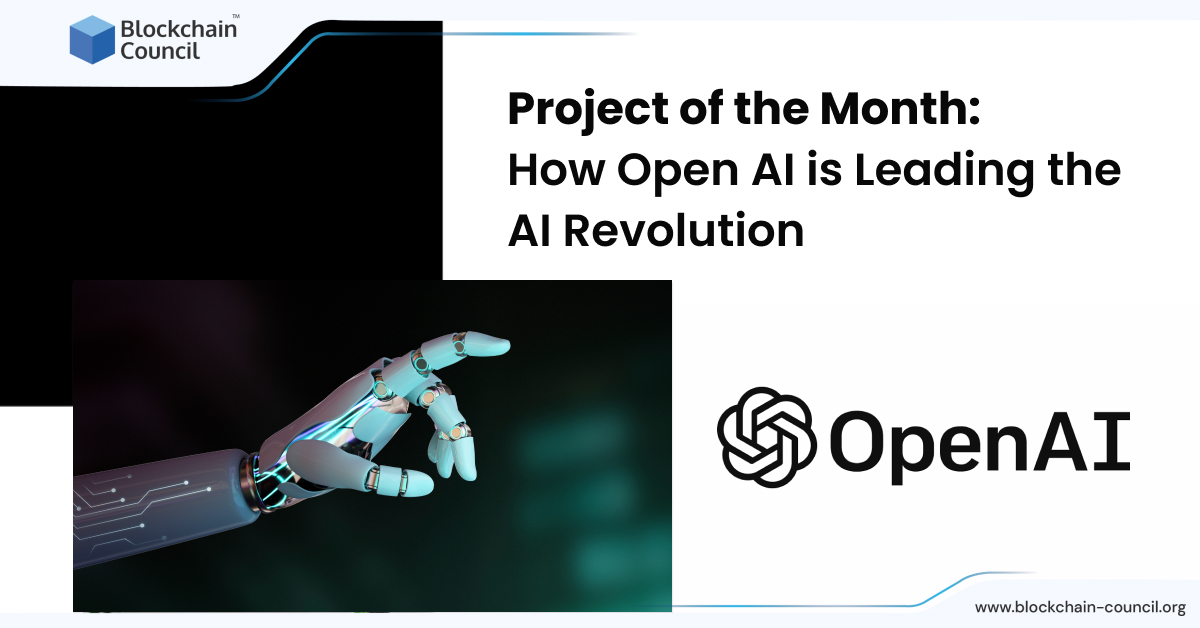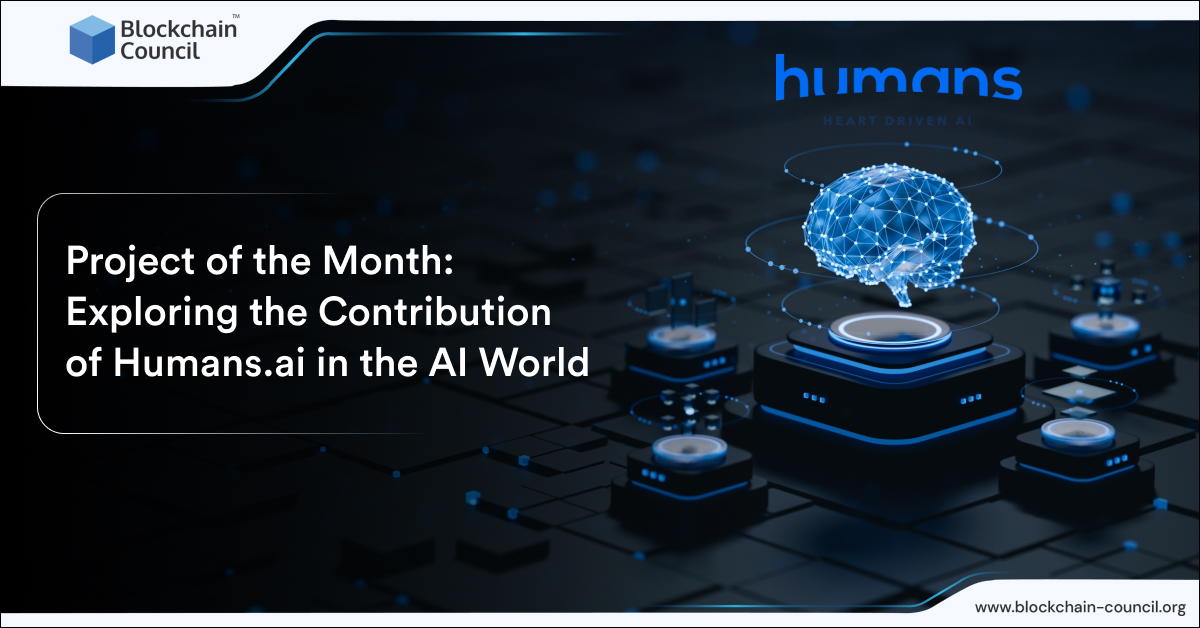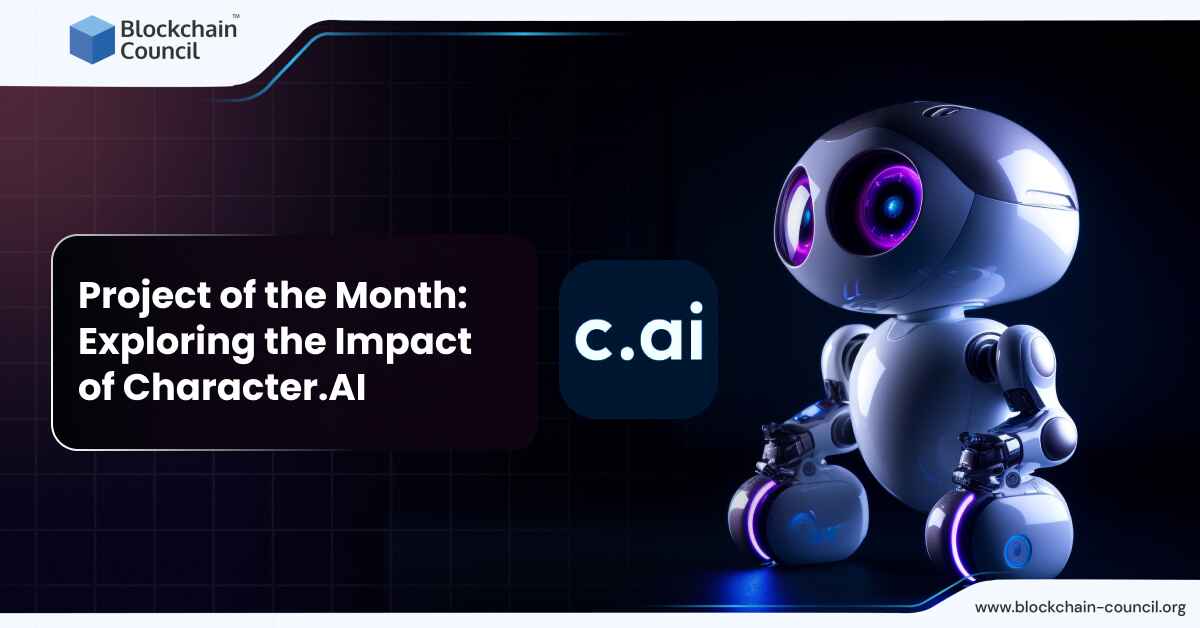
- Blockchain Council
- November 27, 2023
Blockchain Council presents its latest initiative, Project of the Month! Project of the Month is an initiative that recognizes and highlights outstanding projects and initiatives from various fields and industries. Each month, a project is selected based on its innovation, impact, and contribution to the Blockchain, AI, and Web3 fields. This month’s spotlight is on Open AI.
So, what exactly is Open AI?
OpenAI is a research organization focused on developing and promoting friendly artificial intelligence in a safe and beneficial way. Established in 2015, it operates as a hybrid of a for-profit and nonprofit entity, aiming to ensure that AI advancements are broadly and equitably shared across society. OpenAI is renowned for its significant contributions to the field of AI, including the development of cutting-edge language models like GPT (Generative Pre-trained Transformer) series and DALL-E, an AI system capable of generating images from textual descriptions. The organization collaborates with other research and policy institutions to address global challenges related to AI, working to guide the ethical development and deployment of these technologies. Through its work, OpenAI seeks to foster a future where AI can be a positive force for humanity.
Founding Story
- December 2015: OpenAI founded by notable individuals, including Elon Musk. Initial funding exceeds $1 billion, with Elon Musk as the largest donor.
- 2015: Greg Brockman recruits top researchers, offering competitive salaries.
- April 2016: OpenAI releases “OpenAI Gym” for reinforcement learning research.
- Late 2016: “Universe” platform introduced for training AI across applications.
- 2017: OpenAI spends $7.9 million on cloud computing for research.
- 2019: Organizational shift to a “capped” for-profit structure, attracting venture fund investments. GPT-2 released.
- 2019: Microsoft invests $1 billion in OpenAI.
- 2020: GPT-3 released.
- 2021: DALL-E released, showcasing image generation capabilities.
- 2023: Microsoft invests an additional $10 billion.
- Late 2022: ChatGPT launched, gaining popularity.
- Early 2023: OpenAI’s valuation reaches $29 billion.
- November 2023: Challenges arise, leading to the temporary suspension of new sign-ups for products like ChatGPT Plus.
OpenAI was founded in December 2015 by a group of notable individuals including Ilya Sutskever, Greg Brockman, Trevor Blackwell, Vicki Cheung, Andrej Karpathy, Durk Kingma, Jessica Livingston, John Schulman, Pamela Vagata, Wojciech Zaremba, with Sam Altman and Elon Musk as the initial board members. The company received significant backing, with over $1 billion pledged by prominent tech figures and companies, although only $130 million was collected by 2019. Elon Musk was its largest donor, but YC Research did not contribute at all.
Greg Brockman played a pivotal role in assembling the initial team, recruiting nine of the top researchers in the field of deep learning by December 2015. OpenAI distinguished itself by paying competitive salaries to attract top talent, who were drawn by its mission and potential, despite offers from other major tech firms.
In its early years, OpenAI made significant strides in AI research and development. By April 2016, it had released “OpenAI Gym,” a platform for reinforcement learning research. Later in the year, OpenAI introduced “Universe,” a software platform for training AI across various applications. However, these advancements required considerable resources, with OpenAI spending $7.9 million on cloud computing in 2017 alone.
The organization’s structure underwent a significant change in 2019, transitioning from a non-profit to a “capped” for-profit, enabling it to attract venture fund investments and offer employee stakes. This move was met with skepticism from some in the AI community, but it allowed OpenAI to scale up its operations and ambitions.
Following this transition, OpenAI continued to innovate, releasing groundbreaking AI models like GPT-2 in 2019, GPT-3 in 2020, and DALL-E in 2021. Each of these releases marked a significant advancement in AI capabilities, with GPT-3 and DALL-E in particular receiving widespread attention for their natural language processing and image generation capabilities, respectively.
OpenAI also received substantial investments from Microsoft, including a $1 billion investment in 2019 and a $10 billion investment in 2023. This funding bolstered OpenAI’s capabilities and facilitated further innovations like ChatGPT, which gained immense popularity following its launch in late 2022.
In early 2023, OpenAI’s valuation reportedly reached $29 billion, and Microsoft announced an additional investment of $10 billion. However, the organization faced challenges, such as balancing its non-profit origins with its for-profit ambitions, and managing the growing demand for its products like ChatGPT Plus, which led to the temporary suspension of new sign-ups in November 2023.
Product Development: The Core Technology behind Open AI
OpenAI has developed several significant products and contributions to the field of artificial intelligence. Here’s a detailed overview of OpenAI’s major products:
1. GPT (Generative Pre-trained Transformer) Series:
– GPT-1: Released in June 2018, this was the first in the series, showcasing the potential of transformers in natural language processing.
– GPT-2: Launched in February 2019, GPT-2 made headlines for its ability to generate coherent and contextually relevant text based on a given prompt. Its release was initially limited due to concerns about potential misuse.
– GPT-3: Introduced in June 2020, GPT-3 was a significant leap forward in terms of scale and capabilities. It offered powerful language understanding and generation, leading to widespread commercial and research applications.
– GPT-4: GPT-4 is the latest in the series, with advancements in language understanding, problem-solving, and creative generation.
2. DALL-E Series:
– DALL-E: Released in January 2021, DALL-E was a groundbreaking AI system capable of generating diverse and creative images from textual descriptions.
– DALL-E 2: A more advanced version, DALL-E 2, demonstrated improved image generation capabilities with finer details and higher resolution outputs.
3. Codex:
– Launched in August 2021, Codex is an AI model designed for translating natural language instructions into code. It powers GitHub Copilot, a tool that helps developers by suggesting whole lines or blocks of code as they type.
4. ChatGPT:
– Introduced in November 2022, ChatGPT is a conversational model built on top of GPT-3.5. It’s designed for a wide range of applications, including chatbots, virtual assistants, and interactive learning tools.
5. Other Research and Contributions:
– Research Papers: OpenAI has published numerous research papers contributing to advancements in AI ethics, safety, reinforcement learning, and unsupervised learning.
– Partnerships and Collaborations: OpenAI has partnered with various organizations and companies to integrate its AI technologies into different applications and services.
– OpenAI Gym: An open-source platform designed to develop and compare reinforcement learning algorithms.
6. AI Safety and Ethics Initiatives:
– OpenAI has been actively involved in AI safety and ethics research, working to ensure that AI technologies are developed and used responsibly.
7. GPT-4 Turbo
This is an enhanced version of the GPT-4 model, offering two variants – one for text analysis and another for processing both text and images. GPT-4 Turbo can handle a 128,000 token context, which is about four times the capacity of GPT-4, effectively managing the equivalent of over 300 pages of text. It is also more economically priced, with significant reductions in input and output token costs compared to standard GPT-4.
8. Assistants APIs
This new feature allows developers to build more sophisticated, agent-like AI applications. It provides tools for building AI assistants that can understand complex commands and leverage various models and tools to execute tasks. This API is expected to enable the creation of AI with more autonomous and intelligent behaviors, suitable for complex customer service scenarios or interactive educational platforms.
9. Custom GPTs and GPT Store
OpenAI plans to allow users to create and publish personalized versions of ChatGPT to a store, featuring creations from verified builders. This marketplace will enable the sharing and monetization of custom GPTs, potentially creating a new ecosystem of purpose-built AI tools.
10. Custom Models
Specialized AI models can now be tailored to the specific needs of organizations, particularly useful in domains with large, proprietary datasets. These models are created in collaboration with OpenAI researchers and offer deep customization options, allowing businesses to integrate AI closely with their unique workflows and data ecosystems.
11. DALL-E 3 API
OpenAI’s advanced text-to-image model, DALL-E 3, is now accessible through an API. This API includes built-in moderation tools and supports various image output formats, enhancing the capabilities for generating images from textual descriptions.
12. Audio API
This new API is a text-to-speech solution that features six preset voices. It provides access to two generative AI models, enabling a broader range of auditory AI applications.
13. Copyright Shield
A significant new feature aimed at providing legal protection to users of the OpenAI platform. This initiative is designed to cover legal fees for customers facing copyright infringement claims related to the use of OpenAI’s generally available features of ChatGPT Enterprise and the developer platform.
Market Penetration Strategy
OpenAI’s market penetration strategy, like that of many technology companies, involves several key components. While specific strategies might evolve over time, typical elements include:
- Innovative Product Development: OpenAI focuses on cutting-edge artificial intelligence research and development. Products like GPT (Generative Pretrained Transformer) models exemplify this, showcasing advanced capabilities in natural language processing. Constant innovation helps in attracting attention in a competitive market.
- Strategic Partnerships and Collaborations: Collaborating with other tech giants, academic institutions, and industry leaders can be pivotal. For instance, OpenAI’s partnership with Microsoft has been significant, providing both technological support and a broader market reach.
- Targeted Marketing and Public Relations: Effective marketing strategies, including social media campaigns, public demonstrations of technology (like showcasing GPT’s capabilities), and participation in tech conferences, help in increasing brand visibility and adoption.
- User-Friendly Interfaces: Making AI technologies accessible to a broader audience through user-friendly platforms. Tools like ChatGPT are designed to be intuitive, encouraging widespread use among individuals and businesses.
- Freemium and Tiered Pricing Models: Offering basic services for free while charging for premium features is a common strategy. This approach allows users to test the product before committing financially, lowering the entry barrier.
- Focus on Diverse Applications: OpenAI’s products cater to a wide range of applications, from language translation and content creation to data analysis and educational tools, broadening its market appeal.
- Community Engagement and Feedback: Engaging with the user community for feedback and improvement suggestions. This not only improves the product but also builds a loyal user base.
- Global Expansion: Penetrating different geographical markets, considering local regulations, and cultural factors. Localization of products (like language adaptations) can be a part of this strategy.
- Ethical and Safe AI Development: Emphasizing the development of AI in an ethical and safe manner, which is crucial for public trust and acceptance, especially given the concerns surrounding AI technology.
- Continuous Learning and Adaptation: Staying abreast of market trends, technological advancements, and competitor strategies to continuously adapt and innovate.
OpenAI’s approach is a blend of technological innovation, strategic marketing, and ethical considerations, aimed at not just penetrating but also expanding the market for AI technologies.
Funding and Growth
OpenAI’s funding history is notable for its substantial support from various sources, reflecting the organization’s growing prominence in the field of artificial intelligence. Here’s a summary of its funding history:
- Foundation and Early Funding (2015-2018): OpenAI was founded in December 2015 by several prominent individuals and organizations, including Sam Altman, Greg Brockman, Elon Musk, and companies like Amazon Web Services and Infosys. Initially, over $1 billion was pledged to the venture, although the actual collected amount was around $130 million until 2019. Elon Musk was the largest donor during this phase.
- Transition to “Capped” For-Profit (2019): In 2019, OpenAI transitioned from a non-profit to a “capped” for-profit entity, with profits capped at 100 times any investment. This change was made to attract investment from venture funds and allow the company to offer equity to its employees. Subsequently, Microsoft partnered with OpenAI, investing $1 billion. This funding was intended to be spent “within five years, possibly much faster,” and was part of a strategy to scale up resources for achieving artificial general intelligence.
- Further Developments and Microsoft Partnership (2020-2023): OpenAI introduced several significant projects in this period, including GPT-3 in 2020 and DALL-E in 2021. In January 2023, Microsoft made a substantial multi-year investment of $10 billion in OpenAI. This deal suggested that Microsoft could receive 75% of OpenAI’s profits until its investment return was secured, along with a 49% stake in the company. This investment was part of Microsoft’s broader strategy to integrate OpenAI’s AI technologies into its products like Bing and Microsoft 365.
- Latest Investments and Valuation (2023): As of May 2023, OpenAI’s latest investment round occurred, contributing to its historical funding total of $11,575,000,000. OpenAI has nine investors, including Tiger Global Management, Sequoia Capital, and Andreessen Horowitz.
How Open AI Differentiates Itself from Its Competitors
Despite its success, OpenAI is not the sole player in the AI field. The industry is witnessing a surge of startups and tech giants like Google entering or expanding in the generative AI space. In 2022, generative AI companies in the U.S. raised about $920 million, with further increases expected. So, how does Open AI stand out? It distinguishes itself from its competitors through several key factors:
Pioneering Generative AI Models
OpenAI is renowned for its large-language models, notably the Generative Pre-trained Transformer (GPT) series, which have demonstrated remarkable capabilities in generating human-like text. Its products like ChatGPT and DALL-E have gained widespread attention and use.
Microsoft Partnership and Investment
OpenAI has received significant backing from Microsoft, amounting to $10 billion. This support has been crucial in its development and scaling of AI models like GPT-4.
Large-Language Model Expertise
OpenAI is renowned for its large-language models, especially GPT (Generative Pre-trained Transformer). These models are not narrowly focused but intended for a broad range of applications, showcasing versatility and wide applicability.
Strong Revenue and Business Model
OpenAI’s business model has been successful, with projected revenues and a clear pricing strategy for its services, like charging for processing prompts in GPT-4 and offering subscription tiers for ChatGPT. The company seeks to achieve $1 billion in revenue by 2024, with various revenue streams, including charging for GPT-4 model usage and a subscription tier for ChatGPT
Innovative Research and Development
OpenAI is renowned for its cutting-edge research and development in AI. It consistently pushes the boundaries of what’s possible in AI technologies. OpenAI’s development of advanced language models like GPT-4, which showcases remarkable improvements in understanding and generating human-like text, is a prime example of its commitment to innovation. This focus on continuous advancement allows OpenAI to stay at the forefront of AI technology, differentiating it from other companies that may not have such a strong emphasis on research.
Open-Source Contributions and Collaboration
A significant aspect of OpenAI’s approach is its commitment to open-source projects and collaboration with the broader AI community. By sharing research findings and tools, OpenAI fosters a collaborative environment that encourages the exchange of ideas and advancements in the field. This open approach not only accelerates the development of AI technologies but also establishes OpenAI as a key player in shaping the future of AI, setting it apart from competitors who might prioritize proprietary technologies and closed ecosystems.
Ethical AI and Safety Standards
OpenAI places a strong emphasis on the ethical development and deployment of AI. It actively engages in research to ensure AI technologies are used for the greater good and to minimize potential risks associated with AI, such as biases in AI models or the misuse of AI technologies. This commitment to ethical AI and safety standards is a core differentiator for OpenAI, as it navigates the complex landscape of AI development with a conscientious and responsible approach.
Diverse Application and Accessibility
OpenAI’s AI technologies are designed to be versatile and accessible, catering to a wide range of applications across different industries. From language translation to content creation, OpenAI’s tools are adaptable and user-friendly, making them accessible to both technical and non-technical users. This universal applicability and ease of use make OpenAI’s offerings stand out in a market where many AI solutions are often niche or require specialized knowledge to implement effectively.
Strategic Partnerships and Industry Impact
Finally, OpenAI’s strategic partnerships with key industry players amplify its influence and reach in the AI landscape. Collaborations with companies across various sectors not only broaden the applicability of OpenAI’s technologies but also provide valuable insights into industry-specific needs and challenges. These partnerships enable OpenAI to tailor its AI solutions effectively and solidify its position as an influential and versatile AI provider.
Conclusion
OpenAI stands at the forefront of the AI landscape, distinguished by its groundbreaking contributions and strategic initiatives. From its foundational principles of ethical AI development to its commitment to collaboration and open-source contributions, OpenAI has established itself as a key player in shaping the future of artificial intelligence. As OpenAI continues to advance, overcoming challenges such as managing the balance between non-profit origins and for-profit ambitions, its trajectory remains influential in shaping the trajectory of AI technology. The organization’s focus on responsible AI development and its ability to adapt to market trends position it as a leader in the dynamic landscape of artificial intelligence.































































 CoreWeave
CoreWeave


 Guides
Guides News
News Blockchain
Blockchain Cryptocurrency
& Digital Assets
Cryptocurrency
& Digital Assets Web3
Web3 Metaverse & NFTs
Metaverse & NFTs
